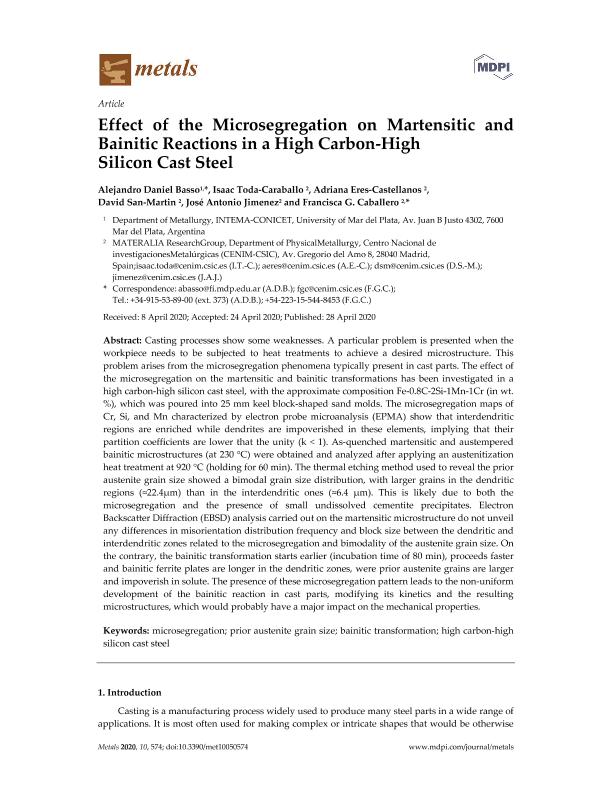Artículo
Effect of the microsegregation on martensitic and bainitic reactions in a high carbon-high silicon cast steel
Basso, Alejandro Daniel ; Toda Caraballo, Isaac; Eres Castellanos, Adriana; San Martin, David; Jimenez, José Antonio; Caballero, Francisca G.
; Toda Caraballo, Isaac; Eres Castellanos, Adriana; San Martin, David; Jimenez, José Antonio; Caballero, Francisca G.
 ; Toda Caraballo, Isaac; Eres Castellanos, Adriana; San Martin, David; Jimenez, José Antonio; Caballero, Francisca G.
; Toda Caraballo, Isaac; Eres Castellanos, Adriana; San Martin, David; Jimenez, José Antonio; Caballero, Francisca G.
Fecha de publicación:
05/2020
Editorial:
Molecular Diversity Preservation International
Revista:
Metals
ISSN:
2075-4701
Idioma:
Inglés
Tipo de recurso:
Artículo publicado
Clasificación temática:
Resumen
Casting processes show some weaknesses. A particular problem is presented when the workpiece needs to be subjected to heat treatments to achieve a desired microstructure. This problem arises from the microsegregation phenomena typically present in cast parts. The effect of the microsegregation on the martensitic and bainitic transformations has been investigated in a high carbon-high silicon cast steel, with the approximate composition Fe-0.8C-2Si-1Mn-1Cr (in wt. %), which was poured into 25 mm keel block-shaped sand molds. The microsegregation maps of Cr, Si, and Mn characterized by electron probe microanalysis (EPMA) show that interdendritic regions are enriched while dendrites are impoverished in these elements, implying that their partition coefficients are lower that the unity (k < 1). As-quenched martensitic and austempered bainitic microstructures (at 230 ⁰C) were obtained and analyzed after applying an austenitization heat treatment at 920 ⁰C (holding for 60 min). The thermal etching method used to reveal the prior austenite grain size showed a bimodal grain size distribution, with larger grains in the dendritic regions (≈22.4µm) than in the interdendritic ones (≈6.4 µm). This is likely due to both the microsegregation and the presence of small undissolved cementite precipitates. Electron Backscatter Diffraction (EBSD) analysis carried out on the martensitic microstructure do not unveil any differences in misorientation distribution frequency and block size between the dendritic and interdendritic zones related to the microsegregation and bimodality of the austenite grain size. On the contrary, the bainitic transformation starts earlier (incubation time of 80 min), proceeds faster and bainitic ferrite plates are longer in the dendritic zones, were prior austenite grains are larger and impoverish in solute. The presence of these microsegregation pattern leads to the non-uniform development of the bainitic reaction in cast parts, modifying its kinetics and the resulting microstructures, which would probably have a major impact on the mechanical properties.
Archivos asociados
Licencia
Identificadores
Colecciones
Articulos(INTEMA)
Articulos de INST.DE INV.EN CIENCIA Y TECNOL.MATERIALES (I)
Articulos de INST.DE INV.EN CIENCIA Y TECNOL.MATERIALES (I)
Citación
Basso, Alejandro Daniel; Toda Caraballo, Isaac; Eres Castellanos, Adriana; San Martin, David; Jimenez, José Antonio; et al.; Effect of the microsegregation on martensitic and bainitic reactions in a high carbon-high silicon cast steel; Molecular Diversity Preservation International; Metals; 10; 5; 5-2020; 1-28
Compartir
Altmétricas



